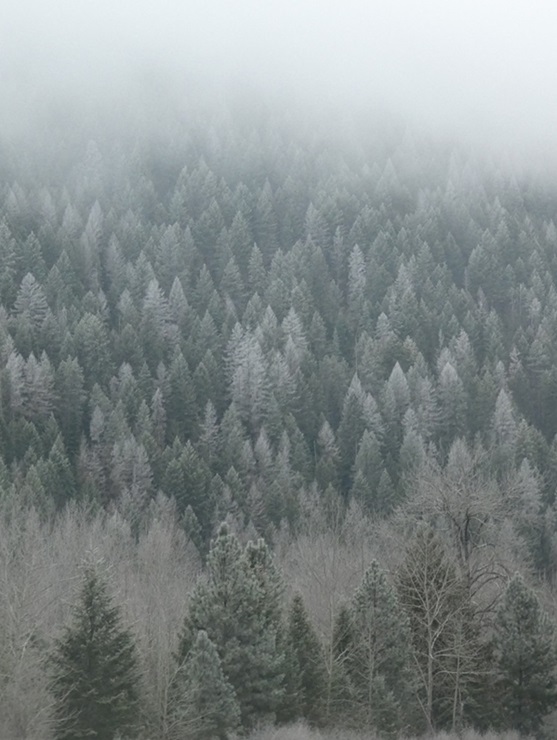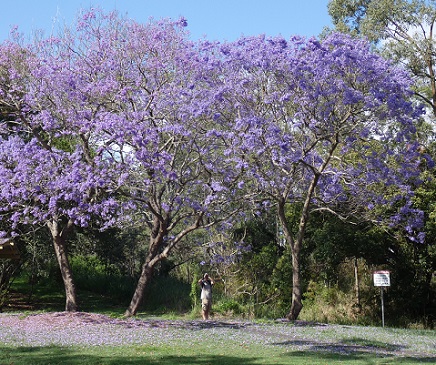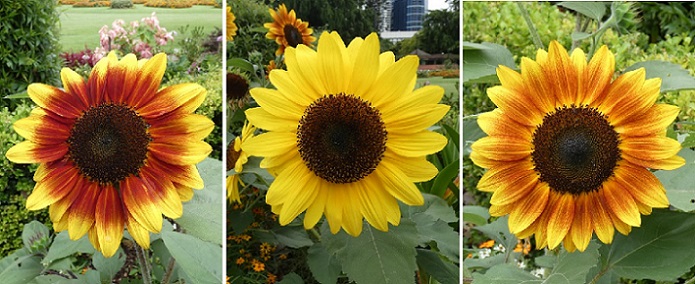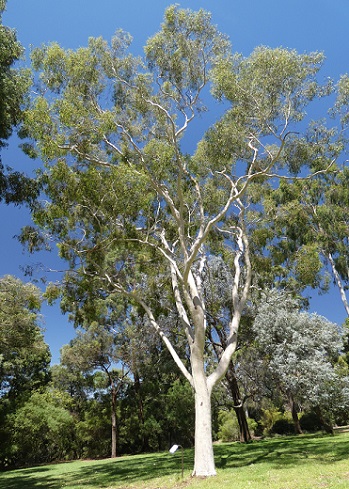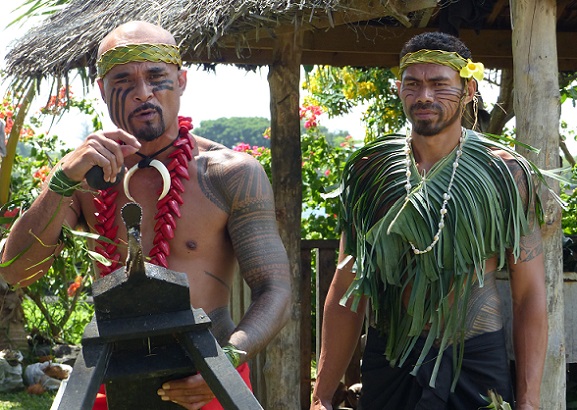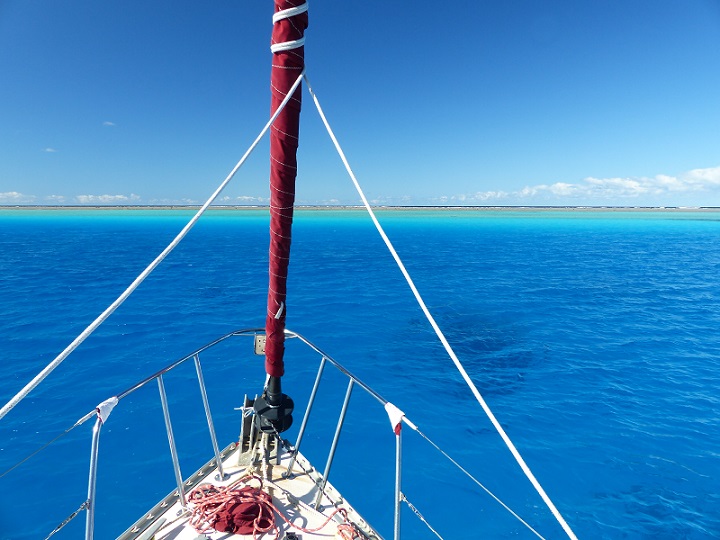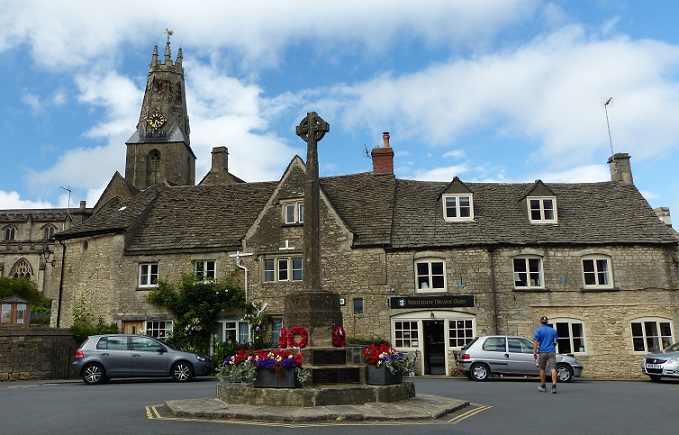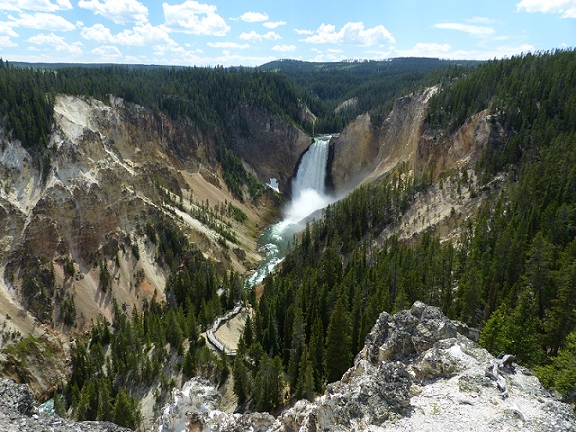
Tregoning
12 April 2024 | We are back aboard Tregoning in Mersin Marina, Mersin, Türkiye
02 April 2024 | We are in Toronto Airport, Canada: Tregoning is in Mersin Marina, Mersin, Türkiye
25 February 2024 | We are back in Gainesville, FL: Tregoning is in Mersin Marina, Mersin, Türkiye
18 February 2024 | We are in Glenwood, New Mexico: Tregoning is in Mersin Marina, Mersin, Türkiye
12 February 2024 | We are in Morro Bay, California: Tregoning is in Mersin Marina, Mersin, Türkiye
19 January 2024 | We are in Vancouver, BC Canada: Tregoning is in Mersin Marina, Mersin, Türkiye
01 January 2024 | We are in Washington State: Tregoning is in Mersin Marina, Mersin, Türkiye
15 December 2023 | We are in Minnesota: Tregoning is in Mersin Marina, Mersin, Türkiye
18 November 2023 | We are in Florida: Tregoning is in Mersin Marina, Mersin, Türkiye
29 October 2023 | We're in Florida - Tregoning is at B-dock, Mersin Marina, Mersin, Türkiye
21 October 2023 | 7 Oda Kapadokya Cave Hotel, Ürgüp, Türkiye
14 October 2023 | Hotel Aşikoğlu, Boğazkale, Türkiye
07 October 2023 | B-dock, Mersin Marina, Mersin, Türkiye
19 September 2023 | “Chez Jon & Angela”, Near Otterton, Devon, UK
14 September 2023 | Airbnb in Fortuneswell on the Isle of Portland, Dorset, UK
11 September 2023 | With Mike, Grange-over-Sands, Cumbria, UK
03 September 2023 | Ardington House, Ardington, Oxfordshire, UK
24 August 2023 | Near "Chez Joan and Peter", College of Roseisle, Moray, Scotland
11 August 2023 | Andrew's house (not exactly), Lichfield, UK
22 July 2023 | Chez Gail, near the New York Café, Budapest, Hungary
In a country without a government
31 August 2017 | Pangai Village, Lifuka Island, Ha’apai Group, Tonga
Photo: Brightly colored fishing boats in Pangai Village, Lifuka Island
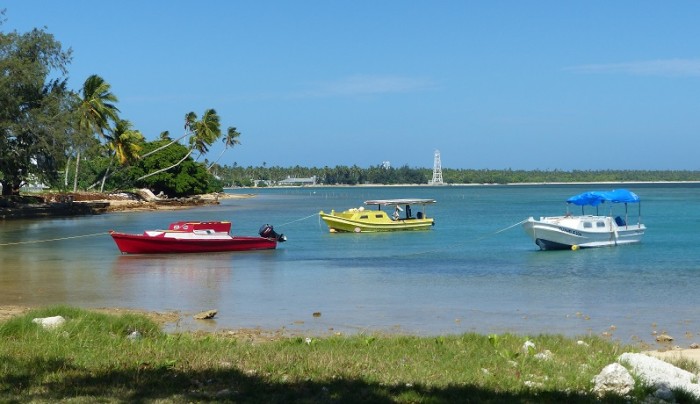
Not only did we not manage to depart from the Ha'apai Islands on Monday (August 28th), but the east to northeasterly winds were predicted to keep us from sailing northeast to Vava'u for another week. Rather than take Tregoning too far afield, we decided to spend some time exploring the island of Lifuka.
We were also curious about whether the political upheaval in Nuku'alofa was having much impact in the rest of the country but there were no obvious signs of any changes in Pangai. Of the few people to whom we talked, most just regarded this as the nation's politicians needing to sort themselves out and having little direct effect on the general population other than expecting a new election on November 16th. Although the Prime Minister and his government were dismissed, they have been retained in a caretaker capacity until the election. More details of the possible reasons and consequences of the dismissal can be found at: https://thediplomat.com/2017/08/king-of-tonga-dismisses-prime-minister-pohivas-government/
Fifita, the lady who runs a guesthouse associated with the Mariner's Café and who organized our laundry, appeared to support the King and not be very impressed with any democratic pushes in parliament to reduce the King's powers. We suspect that her perspective was probably fairly common in the conservative elements of our generation of Tongans but we did not talk to any younger people who might be in favor of more democracy and not be as enthusiastic about the power of the Tongan monarchy.
As is typical in many places, local issues generate more spirited reactions than national politics. We gathered that the sidewalks that were slowly being constructed all around Pangai, were considered by many people to be a complete waste of money and effort. While it is difficult to argue with the safety advantage of sidewalks in many towns, nobody seems to drive very fast in Pangai and the sidewalks did seem a bit elaborate for the small community. We noticed that, as in Nuku'alofa, the new sidewalks were quite narrow making it hard for two people to walk comfortably side-by-side or for people to pass each other. Inevitably, on meeting a large person coming in the opposite direction someone has to step into the road to pass which rather seems to defeat the intent of keep pedestrians safe from the traffic. We did not learn whether this work was a domestic priority or had been funded by foreign aid but looking at the cyclone-damaged state of the market building, for example, it was not hard to see why the locals might feel there were more pressing needs for the funds.

Randall goofing around on part of the new sidewalk along the waterfront in Pangai Village
Given that we were not leaving for Vava'u on Monday, we walked through Pangai with Marisa and Bave to the Velata Mound Fortress. This was one of the tourist sites that was now being publicized on Lifuka Island by big, shiny, new, tourist (brown) signposts. These had appeared since our first visit to the island, and a Visitor's Center had just opened although there was nothing much inside it yet.

Brand-new signposts in Pangai to help the tourists...unfortunately, the Mystery Cross is shown as 7.2 km further away than it is
The fortress was identified by a hard-to-read marble plaque and a painted wooden map in the middle of a partly cleared, muddy field. The actual ditches and mound of the fortress to which the signs referred were still mostly overgrown so it was not really ready for exploration. The plaque explained that the original fortress was built in the 15th century but with little subsequent fighting in the area, it was not refurbished until 1802. After that, the fortress was considered impenetrable and was bitterly defended for a long time by the last Tu'i Tonga, Laufilitonga, and his warriors against "the rising young hero of Ha'apai, Taufa'ahau". The Velata Fortress finally fell in 1827 and this marked the turning point in the history of Ha'apai and Tonga. After Taufa'ahau became King of Ha'apai, he went on to conquer Vava'u and finally Tongatapu. He was proclaimed absolute King of Tonga in 1845, "marking the birth of the new and modern Tonga."

Signs at the overgrown site of the Velata Fortress in Pangai
We were noticing a bit of a pattern to the presentation of historic sites in Tonga. With the notable exception of the well-maintained site of the trilithon on Tongatapu, visits to historic sites in Tonga are mostly opportunities to read marble plaques (on which the paint is disappearing from the letters making them difficult to read) and then looking around and trying to imagine where and what the site had once been like.
For another example, further north on Lifuka Island, the memorial to the massacre of the crew of the ship "Port-au-Prince" also had a hard-to-read, marble plaque accompanied by a painted sign. The ship had been anchored in the nearby bay but there was nothing specific to see related to the event or site other than the signs. The text revealed that in addition to William Mariner, four other sailors survived the massacre but it did not explain what happened to them. It did note that after Mariner returned to England, he became a stockbroker but drowned in a river at the age of 63.

A now-familiar pattern of hard-to-read marble plaque and painted sign near the site of the Port-au-Prince massacre
Interestingly, the inscription was candidly disapproving about the massacre. "This memorial is dedicated to the innocent crew of the Port Au Prince killed in this disgraceful and unfortunate event." There was no comment upon the business of the privateer which would have been an armed ship owned and crewed by private individuals holding a government commission and authorized for use in war, especially in the capture of merchant shipping. Some privateers were regarded as little more than government-sanctioned pirate ships but there was no indication that the crew had intended any harm to the Tongans.
We visited the Port-au-Prince memorial on Wednesday, when we took our bikes to shore and rode to the north end of Lifuka Island and then the full length of the next island, Foa. On the way, the road cut across the runway of the Salote Pilolevu Airport which seemed a rather casual arrangement. There was a narrow cattle-grid (cattle-guard) on each side but these had filled-in with soil so would have had no effect on keeping livestock out. Two flights come and go per day (of course, there are none on Sunday), so we assume that the gates are closed when flights are due.
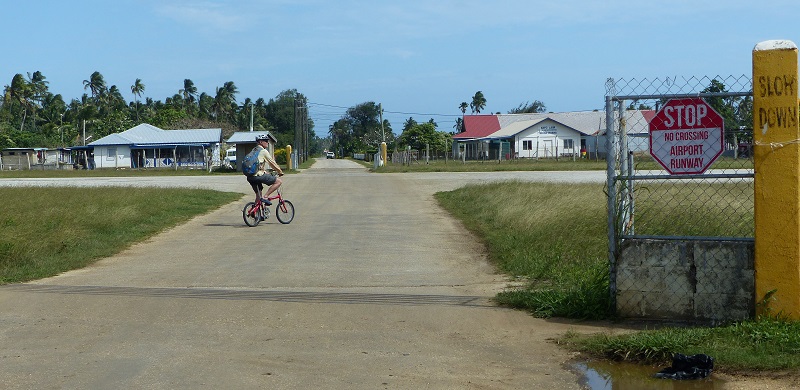
Randall on the main north-south road on Lifuka, about the cross the airport runway
The small but attractive airport terminal that was well ventilated with many jalousie windows (slats of glass that can be angled to keep the rain out even when open), was completed in 1998 having been constructed with aid from the Australian government. Of course, the runway, squeezed onto the widest section of the island, may have originally been built, like so many others in the South Pacific, during World War II.
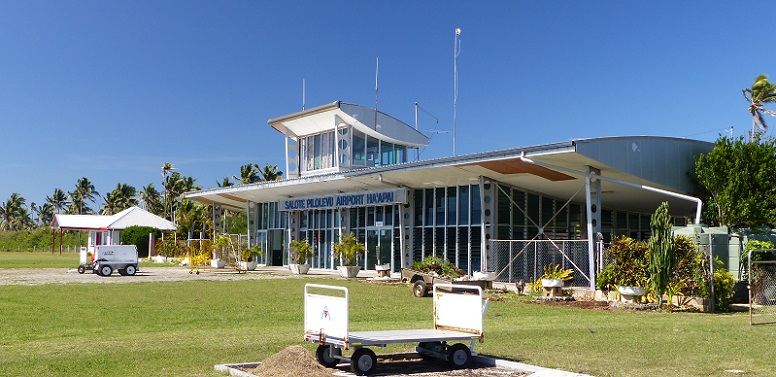
The Salote Pilolevu Airport terminal on Lifuka Island
The road from Likufa Island north to Foa Island, crosses a single-lane causeway (with passing places) which was in much better condition than the "potholed" description in our 2012 edition of the Lonely Planet Guide suggested. That was because the causeway was significantly upgraded in 2013, courtesy of funding from the government of Germany (and possibly resurfaced after the devastation caused by Cyclone Ian in 2014). There were three sections where water flowed westward under the causeway, leaving the lagoon inside the fringing reef. With "damaging swells" from the southeast pounding on the fringing reef, a large amount of water was entering the lagoon, especially at high tide, causing the impressive rush of water through the three narrow exits under the causeway.

Approaching the causeway from Lifuka Island (the lagoon and fringing reef would be to the right)
There are a couple of good-sized villages on Foa. We stopped at a tiny store in the first village to get a snack. In the second village, we ate our picnic lunch in the shade of a large tree, overlooking the concrete wharf and fishing boats on the west side of the island.
We eventually reached the northern tip of Foa where I was interested in scoping-out the snorkeling opportunity between Foa and the small island of Nukunamo where Gail (SV Local Talent) had seen some leopard sharks (a.k.a. zebra shark despite being covered in spots not stripes). With the large swell and easterly winds, the water between the islands was racing westward out of the lagoon just as it had been under the causeway. It would have been a very fast and, depending upon the depth of the coral-heads, potentially hazardous drift-snorkel. It was not obvious that a dinghy could make much headway into the current to get upstream for a chance to drift-snorkel back out and without a dinghy, it might be a long swim back to shore from wherever the current dumped one at the end of the drift. So, reluctantly, I had to accept that we would not be snorkeling the site that day, or likely, for several more days. Even the novice kite-surfers on the beach were being put-off by the strong wind and rushing current.
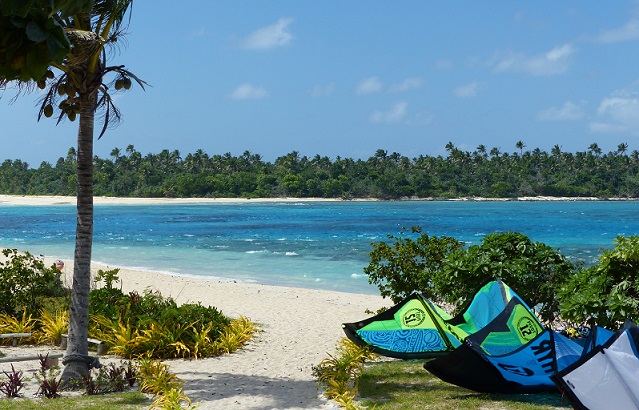
Kite-surfing kites on the grass at the Matafonua resort which overlooks the pass between Foa and Nukunamo Islands
We stopped at the small but neat Matafonua resort for a fruit-juice which was, somehow, accompanied by a banana split...(well, we felt as though we were getting plenty of exercise). We then mounted our bikes for the 14 km (9 mile) ride back to Pangai. At least, we had a little bit of wind-assist on the return ride and it was all pretty flat but both of our rear-ends were a bit tired by the end of the day, having not been on the bikes for three months.
That evening, we were picked-up at the wharf in Pangai and taken to the Ha'apai Beach Resort, on the west coast of Lifuka just north of our anchorage, where we enjoyed a very pleasant evening of cocktails and dinner. The co-owner, Matt from Australia, who gave us a ride back to our dinghy, was pretty content with the full occupancy of the resort for the few months of the whale-watching season. The guests that we had seen all looked very happy with their accommodation. Matt had bought the place in 2012 but has been gradually rebuilding it since the devastation of Cyclone Ian in 2014.
This severe tropical cyclone (category 4 hurricane on the Saffir-Simpson scale) with gusts up to 180 mph (285 km/h) passed directly over the Ha'apai Islands in January 2014. Total damage from the storm amounted to an estimated T$90.2 million (US$48 million) including: 90% of powerlines lost or severely damaged; 80-90% of the area's water supply (mostly rainwater collection tanks) lost; and more than 550 buildings destroyed and about another 200 (including 13 schools) badly damaged. Approximately 2,300 people (out of a population in Ha'apai of 8,200) were left homeless by the storm but, amazingly there was only a single fatality.
With 80% of the residential properties on Lifuka Island destroyed or badly damaged, we realized that this explained the many, identical, prefabricated houses that we were seeing that were both established and being constructed. Some were tiny, apparently single-room buildings grouped together, while others were stand-alone houses that were twice as big.

A typical, post-cyclone Ian, stand-alone prefabricated house with water tank in Pangai Village
Apparently made of thick plywood with jalousie windows and sitting above the ground on short concrete posts, these houses looked as though they would be reasonably comfortable, even in the summer. With steep corrugated metal roofs and gutters leading to large water tanks, they should be self-sufficient for water. However, especially when compared to the concrete-block houses nearby (and on our bike ride we saw concrete blocks being made on Lifuka), it looked as though these prefab buildings would be blown away rather easily in another cyclone. Presumably, the residents would be expected to go to the public shelters (schools and churches) and hope for the best.
With Hurricane Harvey causing flooding devastation in southern Texas and another big storm, Irma, heading for the Caribbean Islands, we were getting a sobering dose of warning about hurricanes. Thus, it was with slight trepidation that we were planning the rest of our cruising schedule for the year. Our plan is to spend about three weeks in Vava'u (depending upon when we get there), and finish our stay in Tonga with a week in Niuatoputapu. Assuming that the winds cooperate, we would plan to sail north to visit Samoa for most of October, then spend a week or so in the French Territory of Wallis before continuing west to Fiji. Spending November in Fiji before returning to New Zealand by mid-December (if the weather is cooperating) would allow us a bit of time to explore the main island of Viti Levu and maybe a few smaller islands nearby.
Since cyclone season officially starts at the beginning of November, we have booked a slip for that month at the Vuda Marina (on the west side of Viti Levu) which is a well-protected "hurricane-hole". Hopefully, there will be no storms in the area that early in the season and we can visit some other anchorages too but we felt that it was important to have a relatively storm-safe option. Of course, if the predictions start to make early-season storms seem likely, we may bolt for New Zealand at an earlier date. We would then plan to visit more of Fiji next winter before moving further west. But we cruisers know that all such plans are written in sand, depending upon the weather and goodness knows what else...
We were also curious about whether the political upheaval in Nuku'alofa was having much impact in the rest of the country but there were no obvious signs of any changes in Pangai. Of the few people to whom we talked, most just regarded this as the nation's politicians needing to sort themselves out and having little direct effect on the general population other than expecting a new election on November 16th. Although the Prime Minister and his government were dismissed, they have been retained in a caretaker capacity until the election. More details of the possible reasons and consequences of the dismissal can be found at: https://thediplomat.com/2017/08/king-of-tonga-dismisses-prime-minister-pohivas-government/
Fifita, the lady who runs a guesthouse associated with the Mariner's Café and who organized our laundry, appeared to support the King and not be very impressed with any democratic pushes in parliament to reduce the King's powers. We suspect that her perspective was probably fairly common in the conservative elements of our generation of Tongans but we did not talk to any younger people who might be in favor of more democracy and not be as enthusiastic about the power of the Tongan monarchy.
As is typical in many places, local issues generate more spirited reactions than national politics. We gathered that the sidewalks that were slowly being constructed all around Pangai, were considered by many people to be a complete waste of money and effort. While it is difficult to argue with the safety advantage of sidewalks in many towns, nobody seems to drive very fast in Pangai and the sidewalks did seem a bit elaborate for the small community. We noticed that, as in Nuku'alofa, the new sidewalks were quite narrow making it hard for two people to walk comfortably side-by-side or for people to pass each other. Inevitably, on meeting a large person coming in the opposite direction someone has to step into the road to pass which rather seems to defeat the intent of keep pedestrians safe from the traffic. We did not learn whether this work was a domestic priority or had been funded by foreign aid but looking at the cyclone-damaged state of the market building, for example, it was not hard to see why the locals might feel there were more pressing needs for the funds.

Randall goofing around on part of the new sidewalk along the waterfront in Pangai Village
Given that we were not leaving for Vava'u on Monday, we walked through Pangai with Marisa and Bave to the Velata Mound Fortress. This was one of the tourist sites that was now being publicized on Lifuka Island by big, shiny, new, tourist (brown) signposts. These had appeared since our first visit to the island, and a Visitor's Center had just opened although there was nothing much inside it yet.

Brand-new signposts in Pangai to help the tourists...unfortunately, the Mystery Cross is shown as 7.2 km further away than it is
The fortress was identified by a hard-to-read marble plaque and a painted wooden map in the middle of a partly cleared, muddy field. The actual ditches and mound of the fortress to which the signs referred were still mostly overgrown so it was not really ready for exploration. The plaque explained that the original fortress was built in the 15th century but with little subsequent fighting in the area, it was not refurbished until 1802. After that, the fortress was considered impenetrable and was bitterly defended for a long time by the last Tu'i Tonga, Laufilitonga, and his warriors against "the rising young hero of Ha'apai, Taufa'ahau". The Velata Fortress finally fell in 1827 and this marked the turning point in the history of Ha'apai and Tonga. After Taufa'ahau became King of Ha'apai, he went on to conquer Vava'u and finally Tongatapu. He was proclaimed absolute King of Tonga in 1845, "marking the birth of the new and modern Tonga."

Signs at the overgrown site of the Velata Fortress in Pangai
We were noticing a bit of a pattern to the presentation of historic sites in Tonga. With the notable exception of the well-maintained site of the trilithon on Tongatapu, visits to historic sites in Tonga are mostly opportunities to read marble plaques (on which the paint is disappearing from the letters making them difficult to read) and then looking around and trying to imagine where and what the site had once been like.
For another example, further north on Lifuka Island, the memorial to the massacre of the crew of the ship "Port-au-Prince" also had a hard-to-read, marble plaque accompanied by a painted sign. The ship had been anchored in the nearby bay but there was nothing specific to see related to the event or site other than the signs. The text revealed that in addition to William Mariner, four other sailors survived the massacre but it did not explain what happened to them. It did note that after Mariner returned to England, he became a stockbroker but drowned in a river at the age of 63.

A now-familiar pattern of hard-to-read marble plaque and painted sign near the site of the Port-au-Prince massacre
Interestingly, the inscription was candidly disapproving about the massacre. "This memorial is dedicated to the innocent crew of the Port Au Prince killed in this disgraceful and unfortunate event." There was no comment upon the business of the privateer which would have been an armed ship owned and crewed by private individuals holding a government commission and authorized for use in war, especially in the capture of merchant shipping. Some privateers were regarded as little more than government-sanctioned pirate ships but there was no indication that the crew had intended any harm to the Tongans.
We visited the Port-au-Prince memorial on Wednesday, when we took our bikes to shore and rode to the north end of Lifuka Island and then the full length of the next island, Foa. On the way, the road cut across the runway of the Salote Pilolevu Airport which seemed a rather casual arrangement. There was a narrow cattle-grid (cattle-guard) on each side but these had filled-in with soil so would have had no effect on keeping livestock out. Two flights come and go per day (of course, there are none on Sunday), so we assume that the gates are closed when flights are due.

Randall on the main north-south road on Lifuka, about the cross the airport runway
The small but attractive airport terminal that was well ventilated with many jalousie windows (slats of glass that can be angled to keep the rain out even when open), was completed in 1998 having been constructed with aid from the Australian government. Of course, the runway, squeezed onto the widest section of the island, may have originally been built, like so many others in the South Pacific, during World War II.

The Salote Pilolevu Airport terminal on Lifuka Island
The road from Likufa Island north to Foa Island, crosses a single-lane causeway (with passing places) which was in much better condition than the "potholed" description in our 2012 edition of the Lonely Planet Guide suggested. That was because the causeway was significantly upgraded in 2013, courtesy of funding from the government of Germany (and possibly resurfaced after the devastation caused by Cyclone Ian in 2014). There were three sections where water flowed westward under the causeway, leaving the lagoon inside the fringing reef. With "damaging swells" from the southeast pounding on the fringing reef, a large amount of water was entering the lagoon, especially at high tide, causing the impressive rush of water through the three narrow exits under the causeway.

Approaching the causeway from Lifuka Island (the lagoon and fringing reef would be to the right)
There are a couple of good-sized villages on Foa. We stopped at a tiny store in the first village to get a snack. In the second village, we ate our picnic lunch in the shade of a large tree, overlooking the concrete wharf and fishing boats on the west side of the island.
We eventually reached the northern tip of Foa where I was interested in scoping-out the snorkeling opportunity between Foa and the small island of Nukunamo where Gail (SV Local Talent) had seen some leopard sharks (a.k.a. zebra shark despite being covered in spots not stripes). With the large swell and easterly winds, the water between the islands was racing westward out of the lagoon just as it had been under the causeway. It would have been a very fast and, depending upon the depth of the coral-heads, potentially hazardous drift-snorkel. It was not obvious that a dinghy could make much headway into the current to get upstream for a chance to drift-snorkel back out and without a dinghy, it might be a long swim back to shore from wherever the current dumped one at the end of the drift. So, reluctantly, I had to accept that we would not be snorkeling the site that day, or likely, for several more days. Even the novice kite-surfers on the beach were being put-off by the strong wind and rushing current.

Kite-surfing kites on the grass at the Matafonua resort which overlooks the pass between Foa and Nukunamo Islands
We stopped at the small but neat Matafonua resort for a fruit-juice which was, somehow, accompanied by a banana split...(well, we felt as though we were getting plenty of exercise). We then mounted our bikes for the 14 km (9 mile) ride back to Pangai. At least, we had a little bit of wind-assist on the return ride and it was all pretty flat but both of our rear-ends were a bit tired by the end of the day, having not been on the bikes for three months.
That evening, we were picked-up at the wharf in Pangai and taken to the Ha'apai Beach Resort, on the west coast of Lifuka just north of our anchorage, where we enjoyed a very pleasant evening of cocktails and dinner. The co-owner, Matt from Australia, who gave us a ride back to our dinghy, was pretty content with the full occupancy of the resort for the few months of the whale-watching season. The guests that we had seen all looked very happy with their accommodation. Matt had bought the place in 2012 but has been gradually rebuilding it since the devastation of Cyclone Ian in 2014.
This severe tropical cyclone (category 4 hurricane on the Saffir-Simpson scale) with gusts up to 180 mph (285 km/h) passed directly over the Ha'apai Islands in January 2014. Total damage from the storm amounted to an estimated T$90.2 million (US$48 million) including: 90% of powerlines lost or severely damaged; 80-90% of the area's water supply (mostly rainwater collection tanks) lost; and more than 550 buildings destroyed and about another 200 (including 13 schools) badly damaged. Approximately 2,300 people (out of a population in Ha'apai of 8,200) were left homeless by the storm but, amazingly there was only a single fatality.
With 80% of the residential properties on Lifuka Island destroyed or badly damaged, we realized that this explained the many, identical, prefabricated houses that we were seeing that were both established and being constructed. Some were tiny, apparently single-room buildings grouped together, while others were stand-alone houses that were twice as big.

A typical, post-cyclone Ian, stand-alone prefabricated house with water tank in Pangai Village
Apparently made of thick plywood with jalousie windows and sitting above the ground on short concrete posts, these houses looked as though they would be reasonably comfortable, even in the summer. With steep corrugated metal roofs and gutters leading to large water tanks, they should be self-sufficient for water. However, especially when compared to the concrete-block houses nearby (and on our bike ride we saw concrete blocks being made on Lifuka), it looked as though these prefab buildings would be blown away rather easily in another cyclone. Presumably, the residents would be expected to go to the public shelters (schools and churches) and hope for the best.
With Hurricane Harvey causing flooding devastation in southern Texas and another big storm, Irma, heading for the Caribbean Islands, we were getting a sobering dose of warning about hurricanes. Thus, it was with slight trepidation that we were planning the rest of our cruising schedule for the year. Our plan is to spend about three weeks in Vava'u (depending upon when we get there), and finish our stay in Tonga with a week in Niuatoputapu. Assuming that the winds cooperate, we would plan to sail north to visit Samoa for most of October, then spend a week or so in the French Territory of Wallis before continuing west to Fiji. Spending November in Fiji before returning to New Zealand by mid-December (if the weather is cooperating) would allow us a bit of time to explore the main island of Viti Levu and maybe a few smaller islands nearby.
Since cyclone season officially starts at the beginning of November, we have booked a slip for that month at the Vuda Marina (on the west side of Viti Levu) which is a well-protected "hurricane-hole". Hopefully, there will be no storms in the area that early in the season and we can visit some other anchorages too but we felt that it was important to have a relatively storm-safe option. Of course, if the predictions start to make early-season storms seem likely, we may bolt for New Zealand at an earlier date. We would then plan to visit more of Fiji next winter before moving further west. But we cruisers know that all such plans are written in sand, depending upon the weather and goodness knows what else...
Comments
| Vessel Name: | Tregoning |
| Vessel Make/Model: | Morgan Classic 41 |
| Hailing Port: | Gainesville, FL |
| Crew: | Alison and Randall |
| About: | We cast-off from Fernandina Beach in north Florida on 1st June 2008 and we have been cruising on Tregoning ever since. Before buying Tregoning, both of us had been sailing on smaller boats for many years and had worked around boats and water throughout our careers. |
| Extra: | “Tregoning” (rhymes with “belonging”) and is a Cornish word (meaning “homestead of Cohnan” or “farm by the ash trees”) and was Alison's mother’s middle name. Cornwall is in southwest England and is where Alison grew-up. |
Tregoning's Photos - Main
 |
Extra photographs from our three-week campervan tour of the South Island from November 15th to December 5th 2015
217 Photos
Created 4 January 2016
|
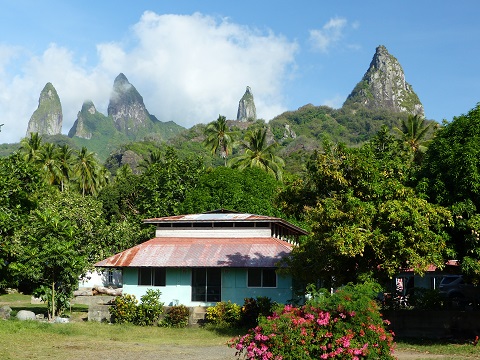 |
Random pictures from our month spent on the islands of Hiva Oa, Tahuata, Ua Pou, and Nuku Hiva
45 Photos
Created 18 July 2015
|
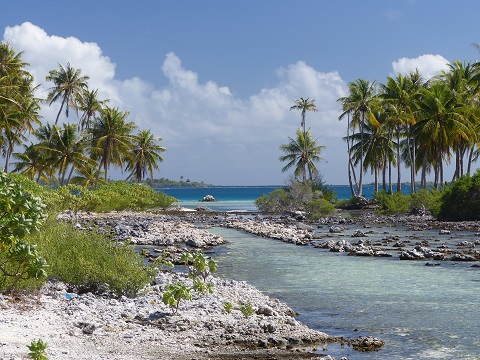 |
Random pictures from our month spent in 4 Tuamotu Atolls; Ahe, Fakarava, Tahanea, and Toau
32 Photos
Created 1 July 2015
|
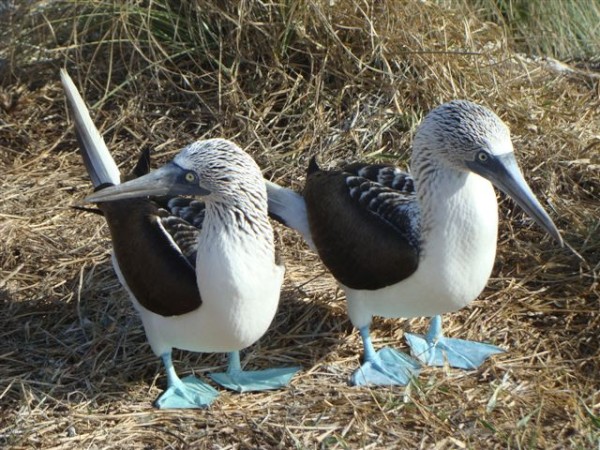 |
Some of the birds, fish, reptiles, and mammals (and others) that we have seen in Mexico
74 Photos
Created 5 May 2014
|
Tregoning

Who: Alison and Randall
Port: Gainesville, FL
